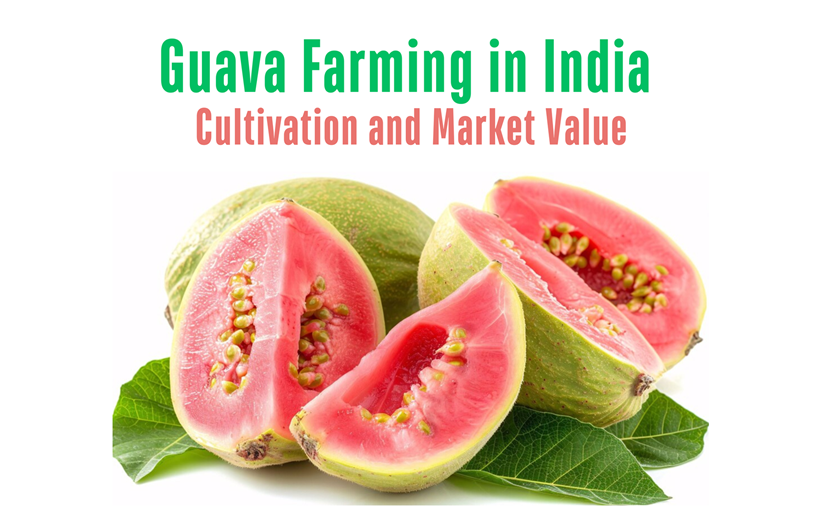Guava Farming in India: A Complete Guide for Beginners

Guava, commonly known as "poor man's apple", is a sweetly loved tropical fruit, providing nutrition and versatility. Abounding in Vitamin C, dietary fibre, and antioxidants, it is delicious and healthy as well. Guava farming will be very rewarding for farmers of any scale, small or large. Rightly handled, they offer excellent yields and profit. One can read the step-by-step guide to this farming below.
Steps to Grow Guavas on Your Farm:
In the following section, one can read about the various stages of guava farming. Without these stages, one won’t be able to grow healthy guavas. So read them carefully.
Choosing the Right Guava Variety
Before planting, choose a guava variety that is suitable for your region. Some popular varieties are:
-
Allahabad Safeda: White pulp and sweet.
-
L-49 (Lucknow-49): High-yielding variety with good market value.
-
Pink Guava: Pink pulp and high nutritional content.
Make sure that the saplings or seeds are obtained from a reliable nursery.
Soil Preparation
Guava thrives well in a wide variety of soils, from sandy loam to clay; however, it prefers very well-drained soils rich in organic matter. The ideal soil pH ranges from 6.0 to 7.0.
Steps for Soil Preparation:
-
Land Clearing: Eliminate all types of weeds, stones, and other debris on land.
-
Ploughing: Using a mini tractor to loosen up soil by mini tractor allows deeper penetration and more root aeration.
-
Leveling: After ploughing, level the area to avoid waterlogging Add organic manures Mix compost or well-rotted farm yard manure into the soil to make it fertile.
Climate and Planting Time
Guava loves the tropical and subtropical climate. The moderate rainfalls along with the temperature between 23°C to 28°C, help it grow properly. Guava can tolerate drought, but it requires areas with good irrigation facilities.
-
Planting Time: The best time to plant guava is during the monsoon, June to September. In irrigated areas, however, you can plant it any time of the year.
Plantation
-
Spacing: Space the plants 5-6 meters apart so that proper growth and airflow are facilitated.
-
Pits Preparation: Dig pits with a dimension of 60 cm x 60 cm x 60 cm in size. Fill the pits with the mixture comprising soil, compost, and organic fertilizer.
-
Planting: Put saplings centrally in the pit and drape soil over them. Sprinkle water upon planting at the same time.
Irrigation Techniques
Once guava trees mature, they can survive without water. However, seedlings should be well irrigated until two years after planting. Provide sufficient irrigation during dry periods and during critical growth steps such as flowering and fruiting to maximize production.
To save water and at the same time, ensure that soil moisture is constant, drip irrigation or sprinkler irrigation may be adopted.
Pruning and Training Stage
Pruning is important for healthy growth and high-quality fruit. Remove dead, diseased, or overcrowded branches frequently. Proper pruning improves the penetration of light and air within the canopy, thereby enhancing fruit quality as well as reducing the probability of pests and diseases.
Train the plant to grow with a single main stem in its early stages, as this encourages a strong trunk and better overall structure.
Fertilizer Application Process
Balanced fertilization is very important for guava farming. Guava trees need a combination of both macronutrients and micronutrients to grow well and develop fruits.
-
Macronutrients: Nitrogen (N), Phosphorus (P), and Potassium (K) are necessary to give good growth and excellent yield.
-
Micronutrients: Zinc and boron enhance fruit quality and shelf life.
Fertilization takes place in split doses while in the active growing, flowering, and fruiting periods. Organic fertilizers like compost and vermicompost can also be used for maintaining healthy soil for plants.
Pest and Disease Management
Although guava trees are resistant, they can also be affected by pests and diseases. The common pests are fruit flies, aphids, and mealybugs. Wilt and anthracnose are some of the common diseases in the cultivation of guava.
Prevention and Control:
-
One should use organic sprays such as neem oil to control the pests naturally.
-
Biological control agents like ladybugs can be introduced to control the injurious insects.
-
Maintain the cleanliness of the orchard through the removal of the plant parts infested by these fungi.
-
Whenever necessary, treat the fungi with fungicides.
Harvesting Stage
Guava trees start producing fruits 2-3 years after planting. The fruits are ready to be harvested 4-5 months after flowering.
Indications of Mature Fruits:
-
The fruit turns from dark green to light green or yellowish.
-
The surface of the fruit becomes slightly soft, and a pleasant aroma appears.
Harvest guavas by hand to avoid bruising and damage. Pick fruits regularly to encourage further flowering and fruiting.
Post-Harvesting Stage
Post-harvesting care is crucial in maintaining the quality and shelf life of guavas.
-
Sorting and Grading: After harvesting, sort the fruits by size, color, and quality to meet market standards.
-
Storage: Store guavas in a cool, dry place to prevent spoilage. Refrigeration can extend their shelf life.
-
Transportation: Sturdy crates to avoid mechanical damage. A good tractor like Mahindra tractor will help farmers transport guavas efficiently to markets or processing units saving time and effort.
The Final Words:
Guava farming is a great option for small and large farmers because of its low maintenance and high profitability. Proper soil preparation, good farming practices, and efficient post-harvest handling will yield consistent income and satisfaction in guava farming.
- Industry
- Art
- Causes
- Crafts
- Dance
- Drinks
- Film
- Fitness
- Food
- Jeux
- Gardening
- Health
- Domicile
- Literature
- Music
- Networking
- Autre
- Party
- Religion
- Shopping
- Sports
- Theater
- Wellness
- News


